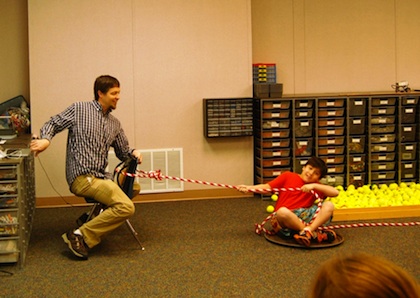Funding, Grants & Awards | News
Teachers Honored for the Innovative Use of Tech in Science Ed
- By Dian Schaffhauser
- 04/07/14
Friction, rocketry and alternative energy are some of the projects undertaken by the latest crop of teachers who have been named winners in an annual competition put on by the National Science Teachers Association (NSTA) and Vernier, a company that sells scientific equipment for teachers. All of the educators were selected based on their use of data-collection technology in science classes. The six winners in K-12 were honored during this year's NSTA National Conference and received $1,000 in cash, $3,000 in Vernier products and $1,500 toward travel expenses to attend the event in Boston.
Bill Burton, a science teacher at the Lamplighter School in Dallas, uses a Vernier Force Plate to help his first grade students learn about friction. In the experiment they experience the forces required to overcome friction as they pull themselves across different surfaces, including several hundred tennis balls. The Force Plate collects real-time data that's projected on the classroom interactive whiteboard for discussion. Burton had demonstrated his lesson during last year's NSTA conference and then wrote an article, "Experiencing Friction in First Grade," about the experiment for the NSTA journal, Science and Children.
| |

Lamplighter School Teacher Bill Burton teaches students about friction. |
|
David Auerbach with Cardigan Mountain School in Canaan, NH puts on the "C-Prize" project, a takeoff on the X-Prize. To learn about speed, velocity and acceleration, students construct and test rocket prototypes. The experimentation includes developing hypotheses and analyzing data they've collected with the use of a Vernier Photogate, a timing device used for precise measurements of high-speed or short-duration events.
Christine Gleason from Greenhills School in Ann Arbor, MI, has her eighth-grade students build a classroom-sized alternative energy system as part of an end-of-year project as part of a focus on energy and sustainable resources. In that project students collect electrical power data from their system as well as solar, geothermal and wind turbine energy systems on the campus and then use the data to improve their designs.
Boston University Academy's Gary Garber has his physics students use sensors within a Photogate, a Vernier Motion Detector and an Accelerometer to further their understanding during pendulum experiments. The classes also use a Vernier Wireless Dynamics System to analyze data Garber collected from a pendulum experiment he performed during a NASA reduced gravity flight. The Wireless Dynamics System collects data "free of friction."
Brian Bollone at Northview High School in Grand Rapids, MI has his forensic science students use sensors to research chemical factors during animal decomposition as part of a CSI-like class. Students gather data through daily observations of "maggot mass" and internal temperature testing of stillborn fetal pigs in a secure location on the school campus.
Physics and chemistry Teacher Ashley Webb with DeSoto Central High School in Southaven, MS runs a "Creating Leaders in STEM" program at her school to help her AP physics and environmental students prepare for their AP tests. She also guides them in working with sixth grade students at a local junior high in performing inquiry-based science projects.
"The use of data-collection technology provides students from kindergarten to college with the opportunity to engage in hands-on scientific learning," said David Vernier, co-founder of Vernier and a former physics teacher. "Each of this year's award winners demonstrated truly innovative ways that probeware can enhance the teaching and learning processes in science and STEM classrooms."
The 2015 technology award application is currently available on the Vernier site at vernier.com. The deadline is November 30, 2014.
About the Author
Dian Schaffhauser is a former senior contributing editor for 1105 Media's education publications THE Journal, Campus Technology and Spaces4Learning.